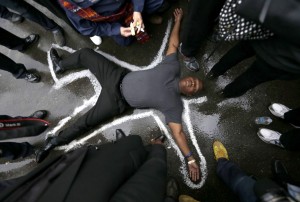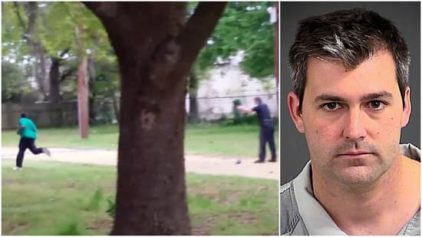
Pastor Charles Burton lies on the driveway of the Ferguson, Mo., police station in October, outlined in chalk as a memorial to Michael Brown, who was fatally shot by a white police officer. Associated Press
This year was seminal in terms of the #BlackLivesMatter movement and Black activism around police violence and the need to reform the criminal justice system.
As the year comes to a close, public health researchers have concluded that police killings are a public health epidemic that should be recorded and treated as such. If this is the case, then there are serious and very real implications for the victims of police violence, who are disproportionately Black people.
The study by researchers at the Harvard T.H. Chan School of Public Health, entitled “Police Killings and Police Deaths Are Public Health Data and Can Be Counted,” was published in the medical journal PLOS Medicine this month. Among its major points, the study noted that over the past year, there have been major controversies and civil unrest around the problem of police violence and police deaths. Meanwhile, although the deaths of police officers are counted, there is no reliable source of accounting for the killing of civilians by the police. Ironically, the most reliable data source for documenting such incidents is a British newspaper, The Guardian, whose tally of deaths by law enforcement this year—known as The Counted— was double the FBI estimate. U.S. Attorney General Loretta Lynch announced the Justice Department will maintain its own system similar to The Guardian. In the past, local police departments have provided such data to the federal government only on a voluntary basis, and that willingness to volunteer this information has been absent.
The authors of the study say that police-related deaths, which include both those killed by law enforcement as well as police officers killed in the line of duty, are not only a criminal justice issue, but a public health matter. After all, these deaths affect the well-being of the families and communities of those who are killed. Further, the Harvard study notes that the total of 842 people killed by police as of September 19, 2015, exceeded the total deaths of people due to pneumonia and influenza (585), measles (188) malaria (786 cases), and mumps (436 cases), and was comparable to number of cases of Hepatitis A nationwide (890 cases).
“We propose that law-enforcement–related deaths be treated as a notifiable condition, which would allow public health departments to report these data in real-time, at the local as well as national level, thereby providing data needed to understand and prevent the problem,” the authors wrote.
This proposal to identify police-related deaths as a monitored public health condition is the first of its kind, setting a precedent for eradicating these killings. The Harvard study is significant because it finds common ground among the disciplines of racial justice, public health and medicine, and reinforces the notion of institutional racism as a public health issue. Police killings certainly are an epidemic, and the year 2015 will be known as a turning point in identifying the issue of police violence as a crisis in need of serious attention. It is no accident that among the people who participated in the die-ins of December 2014 were medical students, part of the national #WhiteCoats4BlackLives movement.
And this past year, there were so many reminders of the scale of police violence against Black bodies. For example, the killing of Freddie Gray, who died of a broken back in a Baltimore police van, precipitated widespread protest and unrest and focused the spotlight on racism, violence and economic exploitation against Black people. The decision to indict the six officers involved in the incident represented one step forward in the march towards justice. The death of Sandra Bland in a Texas jail cell following a problematic traffic stop and arrest, placed the spotlight on the police terrorism facing Black women, as did the conviction of Daniel Holtzclaw, an Oklahoma City cop for the serial rape of 13 Black women.
In addition, a number of high profile police shootings in 2015, complete with video evidence of unarmed Black men being shot in the back or elsewhere, countered the common police narrative of police self-defense in the face of menacing Black criminality. The city of North Charleston paid $6.5 million to the family of Walter Scott, who was shot in the back while fleeing from a police officer, as a passerby captured the incident on his cellphone. Moreover, the dashcam footage of the 2014 Chicago gangland-style execution of Laquan McDonald–shot in a hail of 16 police bullets– fueled protests and economic boycotts in the Black community. Further, the aftermath of Laquan’s death, including the apparent cover-up by city officials, and the indictment of the offending officer for murder a full year after the killing, prompted a full-scale investigation into the Chicago Police Department.
This was also the year that #BlackLivesMatter went to college, helping to connect the violence committed against Black people in the streets and in the prisons to the institutional racism, harassment and terrorism facing young Black people at the nation’s institutions of higher learning. The efforts by students at the University of Missouri, including student activists and striking Mizzou football players, brought down a university administration and brought the university close to the road to reform. This came as Black students at Harvard, Yale and a Princeton forced a discussion linking those schools’ legacy of racism to the current hostile climate facing Black students today.
And students railed against their colleges profiting from the warehousing of Black bodies. For example, through student pressure and organizing, Columbia University became the first to divest its endowment from private prisons. Meanwhile, through the concerted efforts of the Afrikan Black Coalition, a coalition of the Black Student Unions in the University of California system, the UC system divested $25 million from private prisons, a huge victory against a practice these students declared to be “morally rotten and ethically compromising to the mission of any educational institution.”
Yet, 2015 was also the year of sustained pushback and resistance to the #BlackLivesMatter movement, as detractors in an anti-Black counter-movement painted Black protesters as politically-correct whiners on the one hand, and cop killers who sanction violence and lawlessness on the other. All the while, Black people were told the police will not kill them as long as they follow orders and comply with the police. And the deaths continue, because the racism continues.
There is no indication that the war against #BlackLivesMatter will subside in the coming year, which begs the question: If police killings are a disease in which society is in denial and unwilling to treat, then how do you effectively fight that disease?


